| King Edward II | |||||||||||||||||||||||||||||||||||||||||||||||||||||||||||||||
|---|---|---|---|---|---|---|---|---|---|---|---|---|---|---|---|---|---|---|---|---|---|---|---|---|---|---|---|---|---|---|---|---|---|---|---|---|---|---|---|---|---|---|---|---|---|---|---|---|---|---|---|---|---|---|---|---|---|---|---|---|---|---|---|
 6023 King Edward II at Didcot Railway Centre in May 2013 | |||||||||||||||||||||||||||||||||||||||||||||||||||||||||||||||
| |||||||||||||||||||||||||||||||||||||||||||||||||||||||||||||||
| |||||||||||||||||||||||||||||||||||||||||||||||||||||||||||||||
| |||||||||||||||||||||||||||||||||||||||||||||||||||||||||||||||
| |||||||||||||||||||||||||||||||||||||||||||||||||||||||||||||||
Great Western Railway (GWR) 6000 Class 6023 King Edward II is a preserved steam locomotive.
| King Edward II | |||||||||||||||||||||||||||||||||||||||||||||||||||||||||||||||
|---|---|---|---|---|---|---|---|---|---|---|---|---|---|---|---|---|---|---|---|---|---|---|---|---|---|---|---|---|---|---|---|---|---|---|---|---|---|---|---|---|---|---|---|---|---|---|---|---|---|---|---|---|---|---|---|---|---|---|---|---|---|---|---|
 6023 King Edward II at Didcot Railway Centre in May 2013 | |||||||||||||||||||||||||||||||||||||||||||||||||||||||||||||||
| |||||||||||||||||||||||||||||||||||||||||||||||||||||||||||||||
| |||||||||||||||||||||||||||||||||||||||||||||||||||||||||||||||
| |||||||||||||||||||||||||||||||||||||||||||||||||||||||||||||||
| |||||||||||||||||||||||||||||||||||||||||||||||||||||||||||||||
Great Western Railway (GWR) 6000 Class 6023 King Edward II is a preserved steam locomotive.
The locomotive was built at the Great Western Railway's Swindon Works, out-shopped in June 1930. For most of its working life it was allocated to Newton Abbot and Laira depots, working express passenger trains to and from Devon to London Paddington. Withdrawn from Cardiff in June 1962, it was sent to Swindon Works for breaking up. [1] However, in light of the installation of a new bridge west of Bristol towards South Wales, it was coupled to its twin, 6024 King Edward I, and towed to the bridge for weight testing purposes. With both locomotives now closer to South Wales than Swindon, the decision was made to sell them to Woodham Brothers scrapyard in Barry.
Whilst King Edward I was saved in 1974, King Edward II remained at the scrapyard due to the rear driving wheels being flame-cut following a derailment at Woodham Brothers. However, as part of the 150th anniversary of the Great Western Railway in 1985, the hulk was acquired by Harvey's of Bristol, and was moved to a bay platform at Bristol Temple Meads railway station called the Fish Dock.

The Brunel Engineering Centre Trust, under a Manpower Services Commission (MS) scheme, completely dismantled 6023 and restoration began. Work continued until the autumn of 1988, when the MS scheme funding was withdrawn and the future of 6023 was cast into doubt.
6023 was then bought by the Great Western Society (GWS) and moved to the Didcot Railway Centre in March 1990 for its restoration to continue. [2] The restoration included the casting of new rear driving wheels in 1994, followed by re-wheeling the chassis in 1995. The casting is notable since it is thought to be the first wheels to be created for a standard gauge locomotive in preservation. The damaged wheels were also acquired by the GWS at Didcot and can today be seen on display there. Unlike the other preserved "King" class locomotives, the GWS decided to restore 6023 to its as-built single-chimney configuration. All "Kings" had been converted to double chimneys under British Railways ownership, which improved performance and efficiency but changed the original appearance.
On 12 April 2010, King Edward II's boiler passed its steam test, and on 20 January 2011 it moved for the first time under its own power since 1962. [3] It was due to re-enter service on 2 April 2011. [4]
Initially, King Edward II has been painted in the early BR express passenger blue livery, rather than the later standard BR Brunswick Green livery currently carried by 6000 King George V and 6024 King Edward I.
The locomotive re-entered passenger service on the Mid-Norfolk Railway on 4 June 2011, as part of a running-in programme leading to the engine's return to the main line. [5] During the road journey to Dereham, the locomotive lost its safety valve cover, with the Mid-Norfolk offering a cash reward for its safe return. [6] The cover was restored to the locomotive by Sunday 5 June.
On return to Didcot, it was found that the firebox and boiler stays had broken, resulting in the need for a large amount of remedial work to the boiler. On 6 September 2012, the locomotive was moved to Loughborough on the Great Central Railway for firebox repairs, which were completed during early 2013. [7] [8] The locomotive then made a series of appearances on the Great Central Railway, for both testing and running-in purposes but was later returned to Didcot where it was to be prepared to operate on the main line. In 2014, the GWS was given derogation by Network Rail to use a portable GSM-R radio unit on 6023. This unit could then also be used on other GWS locomotives yet to work on the mainline, such as 2999 Lady of Legend and 4079 Pendennis Castle.
Owing to height restriction rules the locomotive had to be reduced in height to comply with the Network Rail loading gauge (the maximum permitted height for steam engines being 13 ft 1 in and the original height of the kings being 4 inches over at 13 ft 5 in). This required the fitment of a cutdown cab and shorter safety valve cover alongside a shorter chimney. The shorter chimney however adversely affected the draughting. A new design of blastpipe with four nozzles was designed and fitted to the engine which after early indications had eliminated the draughting issues on the engine. The other preserved "King" class locomotives 6000 King George V and 6024 King Edward I are both fitted with double chimneys and therefore it was not possible simply to use the same proven blastpipe and chimney arrangement on 6023.
Owing to the amount of time the rectification work took alongside how short the amount of time was left on the engine's boiler ticket, it was decided to abandon the mainline certification until after the engine's next overhaul was completed. An announcement from Didcot later on regarding the ceasing of mainline operations owing to costs and wishing to get more use of their engines, 6023 would now not be undergoing certification to run on the mainline. [9] The only mainline journey it undertook, was to be hauled in light steam by 70013 Oliver Cromwell to a display at Old Oak Common TMD via London Paddington in August 2017. [10] With mainline equipment no longer needed the engine was re-fitted with its original cab and later on its original height safety valve cover and chimney which also included re-fitting its original blastpipe. It made its final journey at Didcot before its boiler certificate expired on 13 September 2020. [11] [12]

The 4073 or Castle Class are 4-6-0 steam locomotives of the Great Western Railway, built between 1923 and 1950. They were designed by the railway's Chief Mechanical Engineer, Charles Collett, for working the company's express passenger trains. They could reach speeds of up to 100 mph (160 km/h).

Didcot Railway Centre is a railway museum and preservation engineering site in Didcot, Oxfordshire, England. The site was formerly a Great Western Railway engine shed and locomotive stabling point.

The British Railways Standard Class 4 4-6-0 is a class of steam locomotives, 80 of which were built during the 1950s. Six have been preserved.

The BR Standard Class 7, otherwise known as the Britannia Class, is a class of 4-6-2 Pacific steam locomotive designed under Robert Riddles for use by British Railways for mixed-traffic duties. 55 were constructed between 1951 and 1954. The design employed results from the 1948 locomotive exchanges undertaken in advance of further locomotive classes being constructed. Three batches were constructed at Crewe Works, before the publication of the 1955 Modernisation Plan.

5051 Drysllwyn Castle is a Great Western Railway (GWR) Castle Class locomotive built at Swindon Works in May 1936 and named after Dryslwyn Castle. It is owned by the Didcot Railway Centre.

The Great Western Railway 2900 Class or Saint Class, which was built by the Great Western Railway's Swindon Works, incorporated several series of 2-cylinder passenger steam locomotives designed by George Jackson Churchward and built between 1902 and 1913 with differences in the dimensions. The majority of these were built as 4-6-0 locomotives; but thirteen examples were built as 4-4-2. They proved to be a highly successful class which established the design principles for GWR 2-cylinder classes over the next fifty years, and influenced similar classes on other British railways.

GWR 4073 "Castle" Class No. 4079 Pendennis Castle is a 4-6-0 steam locomotive built in 1924 for the Great Western Railway (GWR) at Swindon Works to a design of Charles Collett. It was employed on long-distance express passenger trains on the GWR and its successor, British Railways' Western Region.
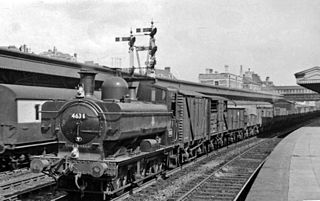
The GWR 5700 Class is a class of 0-6-0 pannier tank steam locomotive built by the Great Western Railway (GWR) and British Railways (BR) between 1929 and 1950. With 863 built, they were the most prolific class of the GWR, and one of the most numerous classes of British steam locomotive.
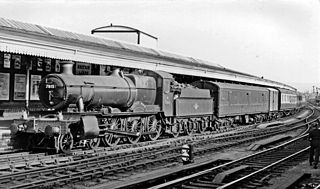
The Great Western Railway (GWR) 7800 Class or Manor Class is a class of 4-6-0 steam locomotive. They were designed as a lighter version of the Grange Class, giving them a wider Route Availability. Like the 'Granges', the 'Manors' used parts from the GWR 4300 Class Moguls but just on the first batch of twenty. Twenty were built between 1938 and 1939, with British Railways adding a further 10 in 1950. They were named after Manors in the area covered by the Great Western Railway. Nine are preserved.

The Great Western Railway (GWR) 6000 Class or King Class is a class of 4-6-0 steam locomotives designed for express passenger work and introduced in 1927. They were the largest locomotives built by the GWR, apart from the unique Pacific. The class was named after kings of the United Kingdom and of England, beginning with the then reigning monarch, King George V, and going back through history. They handled the principal GWR expresses on the main line from London to the West of England and on the Chiltern line to Birmingham and Wolverhampton, until 1962 when the class was withdrawn.

6024 King Edward I is a preserved Great Western Railway (GWR) 6000 Class steam locomotive operated from 1930 to 1962 by the Great Western Railway and latterly British Railways hauling express passenger services.

Great Western Railway (GWR) 6000 Class King George V is a preserved British steam locomotive.

The GWR 4073 Class 5043 Earl of Mount Edgcumbe is a steam locomotive of the GWR 'Castle' Class, built in March 1936. It was originally named Barbury Castle, and was renamed Earl of Mount Edgcumbe in September 1937. It had a double chimney and 4 row superheater fitted in October 1958.

7027 Thornbury Castle was built in August 1949. Its first shed allocation was Plymouth Laira. Its March 1959 shed allocation was Old Oak Common. Its last shed allocation was Reading. It was withdrawn in December 1963 and arrived at Woodham Brothers scrapyard in Barry, South Wales in May 1964. The locomotive was not scrapped and was being restored in 2022.
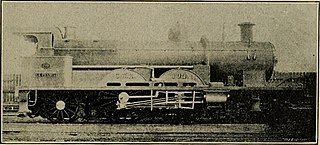
La France, number 102, was a locomotive of the Great Western Railway. It was bought by G.J. Churchward to evaluate French locomotive practice, and particularly the effect of compounding.

The chimney is the part of a steam locomotive through which smoke leaves the boiler. As well, steam locomotive exhaust systems typically vent cylinder steam exhaust through the chimney, to enhance the draught through the boiler. Chimneys are designed to carry the exhaust steam and smoke clear of the driver's line of sight while remaining short enough to clear overhead structures. Some chimneys included apparatus to suppress the dispersal of sparks.

The South African Railways Class 10A 4-6-2 of 1910 was a steam locomotive from the pre-Union era in Transvaal.
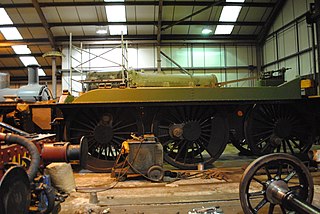
No.1014 County of Glamorgan is a steam locomotive which is under construction as a "new-build" project, based at Didcot Railway Centre in Didcot, Oxfordshire. Unlike most other new-build projects which are underway and are building new members of lost classes like 2007 Prince of Wales and 2999 Lady of Legend it was decided to build a mock of one of the Great Western Railway 1000 or "County" Class engines, the chosen engine being 1014 The project was launched in 2005 with the creation of the 'Three Counties Agreement' between the Great Western Society (GWS) and the Vale of Glamorgan Council saw three members of the Barry 10, all of the being ex-GWR locomotives, and a 3,500-gallon tender being used to help resurrect extinct GWR locomotives. This meant that a GWR 1000 Class No. 1014 County of Glamorgan, GWR 3800 Class No. 3840 County of Montgomery, a GWR 2221 Class tank engine, and a GWR 4700 Class No. 4709 would be constructed from the parts of GWR 2800 Class No. 2861, GWR 5101 Class No. 4115, GWR 5205 Class No. 5227, GWR 6959 Class No. 7927 Willington Hall and LMS 8F No. 48518.
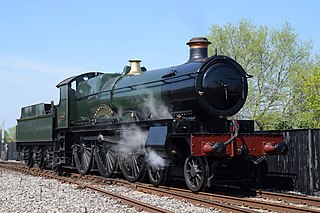
GWR 2900 "Saint" Class No. 2999 Lady of Legend is a 4-6-0 steam locomotive completed in 2019 to a design by George Jackson Churchward. It was based on the frames and boiler of 4900 "Hall" Class No. 4942 Maindy Hall, and was largely constructed at Didcot Railway Centre in Didcot, Oxfordshire, where it is now based. Described as "building the 78th Saint", the project started in the 1970s to look at building a new 'Saint', since none of the original class-members were preserved.

A double chimney is a form of chimney for a steam locomotive, where the conventional single opening is duplicated, together with the blastpipe beneath it. Although the internal openings form two circles, the outside appearance usually forms a single elongated oval.
{{cite magazine}}: Missing or empty |title= (help)[ full citation needed ]